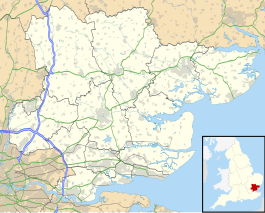railroad.wikisort.org - Station
Blake Hall is a disused former station on the London Underground in the civil parish of Stanford Rivers, and south from the village of Bobbingworth in Essex. It was latterly on the Central line, between North Weald and Ongar, but was originally served by the Epping to Ongar shuttle service branch line.[1][2]
| Blake Hall | |
|---|---|
 | |
 Blake Hall Location of Blake Hall in Essex | |
| Location | Greensted |
| Local authority | Epping Forest |
| Owner | Great Eastern Railway |
| Number of platforms | 1 |
| Key dates | |
| 24 April 1865 | Opened |
| 2 November 1981 | Closed |
| Replaced by | None |
| Other information | |
| WGS84 | 51.7113°N 0.2044°E |
It was opened in 1865 and named after Blake Hall, a country house located a mile or so to the northeast and inhabited by a family of substantial local land-owners. The station was closed in 1981.
History


Blake Hall station was opened by the Great Eastern Railway on 24 April 1865,[3] serving principally as a goods yard carrying agricultural produce from the nearby farms into London.[4] Steam locomotives operated by British Railways for the Underground ran a shuttle service from Epping to Ongar, stopping at Blake Hall, from 1949 until 1957, when the line was electrified and taken over by the Underground's Central line.[5] On 18 April 1966 the goods yard was closed and Blake Hall became a dedicated passenger station. On 17 October 1966, Sunday services were withdrawn.[6]
Blake Hall became reputed as the least-used station on the entire Underground network. Fare subsidies provided on the rest of the system were not provided on this part of the line because local government agencies for Essex and London failed to agree on their respective public transport responsibilities, and Blake Hall station was located a considerable distance from any substantial settlement. By the time the last train ran on 31 October 1981,[7] the station was reported to have only 17 passengers per day. It was permanently closed on 2 November 1981.[8] The Epping to Ongar branch line was closed 13 years later, on 30 September 1994.[9]
Blake Hall's station building has since been converted into a private home[2] and the line passing the station site is now privately owned and operated as a heritage railway by the Epping Ongar Railway. The platform was demolished after closure and reinstated in May 2012 but this is for aesthetic purposes only, and the station remains closed.[10]
See also
- List of former and unopened London Underground stations
References
- Notes
- "London's Abandoned Tube Stations - Epping to Ongar branch". Retrieved 2 July 2012.
- Elvery, Martin (24 July 2021). "Abandoned Tube station that's now a stunning country house". MyLondon. Retrieved 25 July 2021.
- Brown 2006, p. 6
- Croome & Jackson 1981, p. ?
- Horne 1987, p. ?
- Hardy 2011, pp. 175–183
- "Photo collection of Blake Hall station in 1981". Retrieved 2 July 2012.
- Menear 1983, p. ?
- Day & Reed 2005, p. 202
- Skinner, Paul (2011). "Epping Ongar Railway". Retrieved 22 May 2011.
- Bibliography
- Brown, Joe (November 2006). London Railway Atlas. Hersham, UK: Ian Allan Ltd. ISBN 978-0-7110-3137-1. 0611/3.
- Bruce, J. Graeme; Croome, Desmond F. (2006) [1996]. The Central Line (2nd ed.). Harrow, London: Capital Transport. ISBN 1-85414-297-6.
- Croome, Desmond F.; Jackson, A.A. (1981). Rails through the Clay. Harrow, UK: Capital Transport Publishing. ISBN 1-85414-151-1.
- Day, John R.; Reed, John (2005) [1963]. The Story of London's Underground (9th ed.). Harrow, London: Capital Transport. ISBN 1-85414-289-5.
- Hardy, Brian, ed. (March 2011). "How it used to be - freight on The Underground 50 years ago". Underground News. London Underground Railway Society (591). ISSN 0306-8617.
- Horne, M.A.C. (1987). A Short History of the Central Line. London Transport/Douglas Rose & Nebulous Books. ISBN 0-85329-055-5.
- Menear, L. (1983). London Underground Stations: a social and architectural study. Tunbridge Wells, Kent, UK: Midas. ISBN 0-85936-124-1.
External links
- Lyons, James (20 January 2007). "Epping Ongar Railway History - Blake Hall Station". Epping Ongar Railway History. Archived from the original on 8 July 2011. Retrieved 22 May 2011.
- Skinner, Paul (2011). "Epping Ongar Railway". Retrieved 22 May 2011. Epping Ongar Railway's Official Website
| Historical railways | ||||
|---|---|---|---|---|
| North Weald Line and station open |
Great Eastern Railway Loughton-Ongar |
Ongar Line and station open | ||
| Preceding station | Following station | |||
| North Weald towards Epping |
Central line Epping-Ongar branch |
Ongar Terminus | ||
На других языках
[de] Blake Hall (London Underground)
Blake Hall ist eine geschlossene Station der London Underground an der Central Line östlich von Epping. Sie war von 1865 bis 1981 in Betrieb und liegt beim Weiler Greensted in dem zu Essex gehörenden Distrikt Epping Forest. Benannt war sie nach der Blake Hall, dem repräsentativen Wohnsitz lokaler Großgrundbesitzer.- [en] Blake Hall tube station
Другой контент может иметь иную лицензию. Перед использованием материалов сайта WikiSort.org внимательно изучите правила лицензирования конкретных элементов наполнения сайта.
WikiSort.org - проект по пересортировке и дополнению контента Википедии
